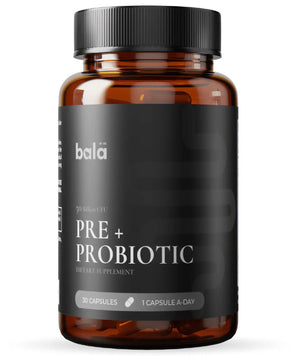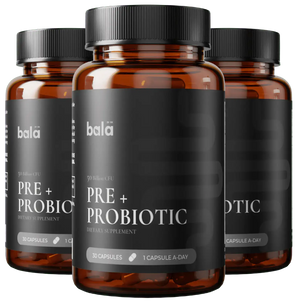Table of Contents
Introduction
Did you know that nearly 70 million Americans suffer from digestive issues? The connection between gut health and our overall well-being cannot be overstated. For many of us, incorporating probiotics into our diets has become an essential part of maintaining a healthy digestive system. But are we aware of the different ways to consume these beneficial bacteria?
One intriguing question we often hear is: Can you use probiotic capsules to make yogurt? This post will delve into that very question while exploring the symbiotic relationship between gut health and homemade yogurt.
At Bala Health, we believe in empowering our community with science-backed knowledge to help simplify their journey towards improved gut health. This article aims to provide clarity on how probiotic capsules can be utilized as a yogurt starter and will cover various aspects of yogurt-making, including the science behind fermentation, the benefits of homemade yogurt, and practical tips for success.
So, are you ready to discover how you can elevate your gut health with homemade yogurt? Let’s dive in!
Understanding Probiotics and Yogurt
What Are Probiotics?
Probiotics are live microorganisms that confer health benefits to the host when consumed in adequate amounts. They are primarily known for their role in supporting gut health by maintaining the balance of beneficial bacteria in our digestive system. Probiotics can be found in various foods, including yogurt, kefir, sauerkraut, and even in capsule or powder form as dietary supplements.
The Role of Probiotics in Gut Health
The gut microbiome consists of trillions of bacteria that play a crucial role in digestion, immune function, and even mental health through the gut-brain axis. When the balance of good and bad bacteria is disrupted, it can lead to various health issues, including bloating, gas, and other digestive discomforts.
Adding probiotics to our diets can help restore this balance. But can we take it a step further and use these probiotics to create our own yogurt at home?
The Science Behind Yogurt Making
Yogurt is a fermented dairy product that is made by introducing specific strains of bacteria to milk. The primary bacteria used for making yogurt are Lactobacillus bulgaricus and Streptococcus thermophilus. These bacteria ferment lactose, the sugar found in milk, producing lactic acid. This process thickens the milk, gives yogurt its tangy flavor, and extends its shelf life.
Why Use Probiotics for Yogurt?
Using probiotic capsules as a yogurt starter is a creative way to combine the benefits of probiotics with the deliciousness of yogurt. The process involves using the live bacteria found in these capsules to ferment milk, transforming it into homemade yogurt.
Benefits of Homemade Yogurt
- Customization: You can adjust flavors, sweetness, and thickness to your liking.
- Cost-Effective: Making yogurt at home can save you money compared to buying premium brands.
- Freshness: Homemade yogurt is free from preservatives and additives, ensuring a clean label.
- Nutrient-Rich: Homemade yogurt can be packed with beneficial bacteria, vitamins, and minerals, contributing to your gut health.
How to Use Probiotic Capsules to Make Yogurt
Choosing the Right Probiotic
When selecting a probiotic capsule for yogurt-making, it's essential to choose a high-quality product that contains live, active cultures. Look for a multi-strain probiotic that includes strains like Lactobacillus acidophilus and Bifidobacterium lactis, as these have been shown to be effective in yogurt fermentation.
Recommended Probiotic Strain for Yogurt
- Lactobacillus bulgaricus and Streptococcus thermophilus: These strains are essential for traditional yogurt-making and should be included in any probiotic capsule you choose.
Ingredients Needed
- Milk (whole, low-fat, or non-dairy alternatives)
- Probiotic capsules (1-2 depending on the quantity of milk)
- Optional: Sweetener (sugar, honey) and flavorings (vanilla, fruit)
Step-by-Step Guide to Making Yogurt with Probiotics
Step 1: Prepare the Milk
- Heat the Milk: Pour your milk into a saucepan and heat it to about 180°F (82°C). This step is essential for pasteurization, which eliminates any unwanted bacteria.
- Cool the Milk: Allow the milk to cool down to approximately 110°F (43°C), which is the ideal temperature for the probiotic cultures to thrive.
Step 2: Inoculate the Milk
- Open the Probiotic Capsules: Once the milk has cooled, open the probiotic capsules and sprinkle the contents into the milk. Stir gently to distribute the bacteria evenly.
- Optional Ingredients: If desired, add sweetener or flavorings at this stage.
Step 3: Incubation
- Transfer the Mixture: Pour the inoculated milk into a clean, sterilized container.
- Incubate: Cover the container with a lid or cloth and place it in a warm environment (around 110°F) for 6-12 hours. You can use a yogurt maker, an oven with the light on, or a warm spot in your kitchen.
- Check for Doneness: After the incubation period, check the yogurt. It should be thickened and have a tangy flavor. If it’s not thick enough, let it incubate for a few more hours.
Step 4: Refrigerate and Enjoy
- Refrigerate: Once the yogurt has reached the desired consistency, transfer it to the refrigerator to stop the fermentation process.
- Save Some for Next Time: Remember to save a quarter cup of your homemade yogurt to use as a starter for your next batch!
Common Challenges in Yogurt Making
1. Yogurt is Too Thin
If your yogurt turns out runny, it could be due to inadequate incubation time or insufficient live cultures. Ensure you use a quality probiotic and allow enough fermentation time.
2. Yogurt is Too Tart
If you find that your yogurt is overly sour, it may have fermented for too long. Adjust the incubation time in future batches to suit your taste.
3. Separation of Whey
It's natural for whey to separate from the yogurt. You can simply stir it back in or drain it off for a thicker consistency.
Tips for Successful Yogurt Making
- Maintain Cleanliness: Ensure all utensils and containers are thoroughly cleaned and sanitized to prevent contamination.
- Temperature Control: Keep the incubation temperature steady for optimal fermentation.
- Experiment: Don’t hesitate to try different milk types or probiotic strains to find your perfect combination.
The Role of Bala Health in Your Gut Health Journey
At Bala Health, we are committed to empowering our community with clean, science-backed probiotics that support gut health. Our flagship probiotic is designed to help ease occasional bloating and support a healthy immune system, making it a perfect addition to your wellness routine.
Are you ready to kick-start your transformation? Take our 3-minute Weight-Loss Quiz to uncover your personalized gut-health roadmap!
Conclusion
Incorporating probiotics into our diets through homemade yogurt is an exciting and rewarding way to enhance our gut health. By using probiotic capsules as a starter culture, we can create delicious and nutritious yogurt right at home.
Not only does homemade yogurt provide a wealth of benefits, but it also allows us to take control of our health and well-being. Remember to experiment, enjoy the process, and share your creations with loved ones.
Feeling inspired to take your gut health journey to the next level? Shop our clinically-backed probiotic now and discover how Bala Health can help you feel better from the inside out!
FAQ
Can I use any probiotic capsule to make yogurt?
Not all probiotic capsules are suitable for yogurt-making. Look for capsules that contain strains like Lactobacillus bulgaricus and Streptococcus thermophilus.
How long does it take to make yogurt using probiotics?
The fermentation process typically takes between 6 to 12 hours, depending on the desired thickness and tanginess.
Can I use non-dairy milk to make yogurt?
Yes, you can use non-dairy milk like almond or coconut milk, but ensure to add a sweetener to help feed the bacteria.
What if my yogurt doesn’t thicken?
If your yogurt is too thin, it may mean you need to increase the incubation time or ensure you are using a high-quality probiotic with live cultures.
Is homemade yogurt healthier than store-bought?
Homemade yogurt can be healthier as it typically contains no preservatives or additives and is often richer in beneficial bacteria. Plus, you can customize it to your preferences!
By understanding the relationship between probiotics and yogurt, we empower ourselves to take control of our gut health. Let's embark on this delicious journey together!






